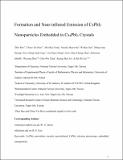Formation and near-infrared emission of CsPbI3 nanoparticles embedded in Cs4PbI6 crystals
Abstract
Cs4PbI6, as a rarely investigated member of the Cs4PbI6(X is a halogen element) family, has been successfully synthesized at low temperatures, and the synthetic conditions have been optimized. Metal iodides such as LiI, KI, NiI2, CoI2, and ZnI2, as additives, play an important role in enhancing the formation of the Cs4PbI6 microcrystals. ZnI2 with the lowest dissociation energy is the most efficient additive to supply iodide ions, and its amount of addition has also been optimized. Strong red to near-infrared (NIR) emission properties have been detected, and its optical emission centers have been identified to be numerous embedded perovskite-type α-CsPbI3 nanocrystallites (∼5 nm in diameter) based on investigations of temperature- and pressure-dependent photoluminescent properties. High-resolution transmission electron microscopy was used to detect these hidden nanoparticles, although the material was highly beam-sensitive and confirmed a “raisin bread”-like structure of the Cs4PbI6 crystals. A NIR mini-LED for the biological application has been successfully fabricated using as-synthesized Cs4PbI6 crystals. This work provides information for the future development of infrared fluorescent nanoscale perovskite materials.
Citation
Bao , Z , Hsiu , C-Y , Fang , M-H , Majewska , N , Sun , W , Huang , S-J , Yuan , E C-Y , Chang , Y-C , Chan , J C C , Mahlik , S , Zhou , W , Yang , C-W , Lu , K-M & Liu , R-S 2021 , ' Formation and near-infrared emission of CsPbI 3 nanoparticles embedded in Cs 4 PbI 6 crystals ' , ACS Applied Materials & Interfaces , vol. 13 , no. 29 , pp. 34742-34751 . https://doi.org/10.1021/acsami.1c08920
Publication
ACS Applied Materials & Interfaces
Status
Peer reviewed
ISSN
1944-8244Type
Journal article
Description
This work was financially supported by the Advanced Research Center of Green Materials Science and Technology from The Featured Area Research Center Program within the framework of the Higher Education Sprout Project by the Ministry of Education (107L9006), the Ministry of Science and Technology in Taiwan (Contracts MOST 109-2113-M-002-020-MY3, MOST 107-2113-M-002-008-MY3, MOST 110-2923-M-002-017-MY3, MOST 107-2923-M-002-004-MY3, and MOST 107-3017-F-002-001), the National Science Center Poland Grant Opus (nos. 2016/23/B/ST3/03911 and 2019/33/B/ST3/00406), and the National Center for Research and Development Poland Grant (no. PL-TW/VIII/1/2021).Collections
Items in the St Andrews Research Repository are protected by copyright, with all rights reserved, unless otherwise indicated.

